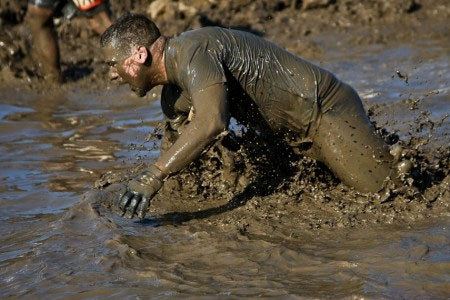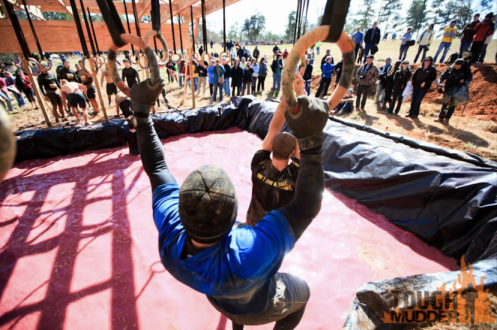I ran my Tough Mudder in the following…
- Adidas Climacool Fitted Jersey (team uniform).
- UnderArmour ColdGear long-sleeve top underneath.
- Brooks quick-drying Running Shorts.
- UnderArmour ColdGear leggings underneath.
- A pair of lightweight Nike Dri-fit fingerless workout gloves.
- Dri-fit socks.
- New Balance Cross Country Racing flats.
UA ColdGear: I had read mixed suggestions about UnderArmour ColdGear, because it’s slightly more absorbent than some other fast-drying fabrics, but I really believe this UA gear kept me warm(ish) as long as possible. The fact is, you will be very cold at some parts of the race, regardless of what you wear. However, my ColdGear dried very quickly and kept me considerably warmer (perhaps “not freezing” is a better description) in the earlier part of the race.
Racing flats: My flats were so lightweight, the water essentially added no weight to them. I highly recommend wearing the lightest (while still supportive) shoes you own. The last thing you want is to feel like you’re running with bricks strapped to your feet for 12+ miles.
Dri-fit Gloves: Gloves were helpful for one big reason, and one smaller reason. The smaller reason is that it will help save your hands when climbing over walls. They do not, I repeat, do not help on the monkey bars. I read this in many places before my race and it was true. Some bars are greased up and even expensive gloves will not combat that. The big reason the gloves were helpful was warmth! Even wearing wet gloves, my hands were incredibly warmer than when I took them off for certain obstacles. Your hands are a crucial part of many obstacles, take care of them and keep them warm!
All other items: No complaints about my other gear. As a general rule, wear as little cotton as possible, preferably NONE AT ALL. Cotton is super-absorbent and will be the death of you on this course.
OBSTACLES:
Any obstacle that requires crawling/running in mud: Place your arms and/or legs down gently. There are often large rocks and boulders that will hurt if you aren’t careful.
Arctic Enema: I would say train with cold showers (as I did), but it didn’t help all that much. What it did help was to teach me that even if your breathing is out of control (which it will be during this obstacle), that you’re okay and just need a few seconds to catch it. I saw some people trying to climb out the sides or over the wall into the barbed wire. DO NOT panic like this. Jump in, catch your breath for a moment, dip under the wall, and get out fast. You’ll be fine. Also, make sure the person ahead of you is almost getting out when you jump in (some people got stuck in the tank because a person ahead of them was struggling to climb out).
Death March: Most people I saw walked this obstacle, so don’t feel ashamed if you have to take a break. I mixed running with walking, as long uphill stretches can destroy your calves and it was too early in the race to risk this.
Hold Your Wood: First, pick a reasonably-sized log. Don’t try to prove something by taking a huge one. Keep alternating shoulders and different grips to work different muscles and avoid exhaustion.
Everest: Spend a few minutes watching others run up. You’ll probably have to do this anyway as you wait your turn. Watching can help you find a good path with enough traction to get you up without a brutal fall. Certain parts of the quarterpipe will be more slippery than others, so it’s worth the wait to find that sweet spot. Then make eye contact with someone up top, and run for your life.
Electric Eel: This was a mystery obstacle for my race. The wires were just spread out enough that you could crawl very carefully in between them (if it’s a windy day, it’s a lost cause). By the end, however, the wires were too low, and I got shocked. My friend, however, didn’t. So it is possible to escape unscathed! Just crawl carefully and deliberately and you’ll manage. While the shock can be painful, it should be the least of your concerns in this race.
Monkey Bars and Rings: Get in a rhythm and hold on tight! If you have the grip strength, you can make it across, even on greased bars. Get a grip strengthener and use it whenever you’re sitting on the couch or watching TV. It’ll be pay dividends in your ability to cross these obstacles dryly. Also, only take one bar at a time, don’t alternate hands like you would at the playground. For the rings, I saw someone insert their entire arms in the rings up to their shoulders which seems like it would be better if your grip is exhausted. On the swing, they would slide their arm in the ring and remain suspended, holding onto both rings in their armpits until they were ready to move on.
Twinkle Toes: Use a ‘T’ foot stance. Your front foot should be facing forward, and your back foot should be perpendicular to your front foot, across the bar. After each step you take with your front foot, close the gap with your back foot. Your arms should be at 45 degree angles downward. When the bar begins to sway a lot, stop moving forward and focus on swaying your legs with the bar until it stabilizes, then continue.
Electroshock Therapy: Do not sprint through this obstacle. If you do and you get shocked, you will faceplant and end up on YouTube. Enter the obstacle at a jogging pace with your head down slightly and arms in front, protecting your face from the wires. It also helps to be wearing long sleeves/leggings because I suspect it reduces the shock somewhat. If you get shocked, just keep moving. If you fall, try to get back up because being continuously shocked in a crawling position makes it more difficult to make forward progress. If you’re standing you can build up more momentum to push you through the rest of the wires.
Good luck and remember to share this experience with people; it’s great to run in small groups!
If you’ve already run a Tough Mudder, please share any tips you have in the comments!













